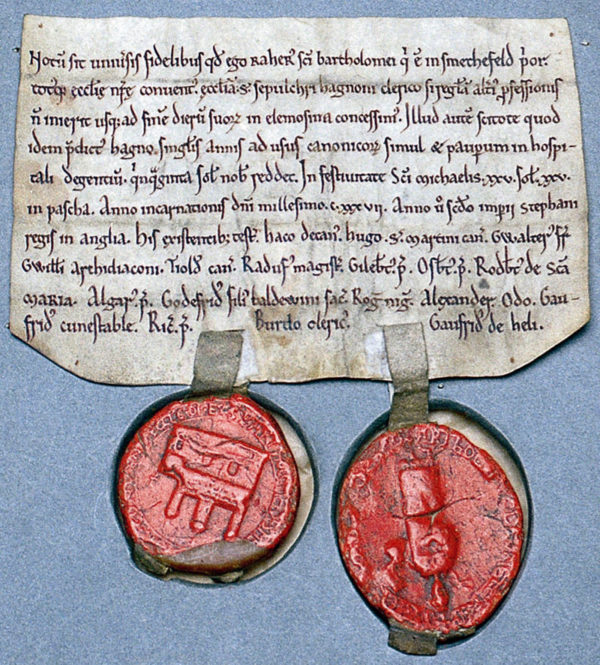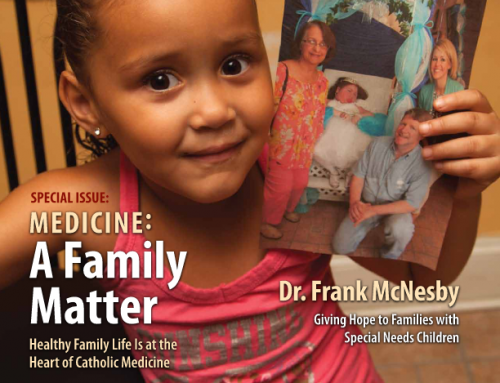From the Catholic Medical Guardian, the quarterly journal of the Guild of St. Luke, St. Cosmas and St. Damian. Vol.1. No. 3 July, 1923 pages 53-54.
The celebration of the 8ooth anniversary of the foundation of St. Bartholomew’s Hospital, the oldest and second largest in London (670 beds), enables Protestant England to realise what it owes to a great Catholic monastic Order. But Bart’s is only one ‘of the many noble institutions which our Catholic forefathers established for the sick and suffering throughout the land, which the rapacity of the great devastation of the sixteenth century has left spared to our day. It was in A.D. 1123 that Rahere, a Canon Regular of the Order of St. Augustine and Prior of the adjacent monastery in Smithfield, established this hospital, and a significant and graceful tribute was paid to that ancient body, which traces its origin to Christ Himself, by the special invitation of the Abbot of the Canons Regular, with the Canons from the four Augustinian houses now in England, to take part in this public homage of grateful memory and admiration for their venerable brother. And it is fitting that their first appearance at this hospital since the “Reformation” should be on so ceremonious an occasion.
The dissolution of the monastic houses and hospitals by Henry VIII so grievously affected this institution that the Mayor of London, moved with compassion for the numbers of the destitute sick and decrepit abandoned to the streets, petitioned that ruthless King who, after five years, eventually granted a charter in 1544, which vested the hospital in the Mayor and Citizens of London. The present structure is, of course, of later erection and development.
The solemn appearance of these Augustinian clergy, announced by a fanfare of trumpets from the roof of the building, fully habited and preceded by cross-bearer between lighted candles, and thurifer censing the air as of yore, coming in procession through the streets to the fountain-centred square fronting the main Smithfield entrance, chanting their ancient Latin hymn in honour of St. Augustine, was an affecting sight to the crowds that gathered. They then offered a commemorative prayer to St. Bartholomew the Apostle and to St. Augustine of Hippo, and, concluding with the intonation of the Psalm “Deus misereatur nostri,” departed whence they came. This moving spectacle cannot but have an influence for good in this country. The Catholic memory carries us back to the time of Pope St. Gregory the Great, who commissioned another St. Augustine, with his forty monks, to preach the Gospel to pagan Anglo-Saxon England (the “non Angli sed Angeli “), and who was welcomed by King Ethelbert to Canterbury in 597· And so, it was also meet that the Prince-heir to the throne, as President of the Hospital, and the Lord Mayor and Aldermen of London, should likewise welcome the descendants of the Austin friars, notwithstanding that their progenitors of old were Benedictines.
The second part of the proceedings included a fanfare of trumpets by the Coldstream and the Welsh Guards, ushering in three historical episodes:
- Rahere, having had his vision of St. Bartholomew· instructing him to found the hospital, returns from Rome and lays before Richard, Bishop of London, his project for the Priory and hospital ;
- Henry VIII grants the charter to the Mayor and Commonalty ; and
- a procession , illustrating the work of the Hospital in the Great War.
Finally Rahere mounts the platform, Henry points to him as the true founder of the institution, and the whole assembly concluded with hymning “O God, our help in ages past.” St. Bartholomew’s Fair, abolished in 1858, was revived for three days to the joy of the students, nurses, and all citizens taking part.
We are grateful to the Times for several erudite and sympathetic articles on this celebration. In a valuable observation it indicates even a closer union of · England and Rome in those far-off days. The Saxon King Ina had established an Anglo-Saxon “schola” by the Tiber early in the eighth century ; towards its close Offa (King of Mercia) enlarged this foundation, transformed it into the “Xenodochium quod Sanctus Spiritus dicitur,” and endowed it with “St. Peter’s Pence.” Thus the most venerable hospital in the world, the Sancto Spirito, whose visiting book is the most wonderful of all autograph collections, is of English origin! Over against it on the island of the Tiber the Emperor Otho Ill built the church in which, by a tradition much earlier than Rahere, there rests the body of St. Bartholomew. Doubtless Rahere visited it. By a coincidence, says the Times, which we however interpret as the set policy of the Catholic Church, the ruins out of which it was built were those of a temple, “Jovis et Æsculapii.” We conclude by mentioning among the great medical names which are associated with “Bart’s,” and which include the illustrious William Harvey,_ the discoverer of the circulation of the blood, the great Abernethy, the famous Radcliffe, and numerous others, including Sir Humphry Rolleston, the present President Royal College of Physicians, London, and Sir Anthony Bowlby, President Royal College of Surgeons, Eng., that of our notable co-religionist Sir Norman Moore, also one time President Royal College of Physicians, who died but six months ago universally mourned, leaving a laborious history of the Hospital in two tomes of 1,600 pages.
EDITOR’S COMMENT.
It is of course, now 900 years since the foundation of the first hospital in London by the Augustinians in 1123. Celebrations for the 900th Anniversary were in March this year. The Church has given so much to this country. Medicine was very much founded upon the very first hospitals of St Bartholomew and soon after St Thomas.
……………………………………………………………………..







